For preppers focused on safety, military-grade gas masks are essential. These masks are designed to protect soldiers from chemical, biological, radiological, and nuclear threats. They meet strict military standards, ensuring they can efficiently filter harmful particles and gases, including radioactive dust, through advanced filtration systems. Owning one provides a high level of respiratory protection, similar to that of military personnel, helping ensure safety when emergency services are unavailable.
Key Takeaways:
- Gas masks are categorized into Full-Face Respirators, Half-Mask Respirators, and Powered Air-Purifying Respirators (PAPRs), each designed for specific scenarios and threats.
- The top recommended gas masks include the MIRA Safety CM-7M and CM-6M, PD-101 and PD-100, and 3M Respirators Fr-M40B.
- Filters are essential for the functionality of gas masks, trapping harmful particles and adsorbing gases.
- Selecting the correct gas mask involves understanding the potential threats, the necessary protection level, and ensuring the mask fits properly to create an airtight seal.
This article gives a closer look into military gas masks, exploring the latest advancements in technology, design, and materials contributing to their effectiveness. Whether for deployment in conflict zones or as a precautionary measure in hazardous work environments, knowing the right gas masks can be a life-saving decision.
Understanding Military Gas Masks: A Primer
When the air itself becomes a weapon, specialized protection is critical. Military gas masks aren’t just a piece of gear; they’re a potential lifeline against some of the most dangerous threats imaginable.
Military gas masks create an airtight seal around your face, forcing all inhaled air to pass through specialized filters. These filters trap harmful substances, ranging from chemical agents and biological toxins to radioactive dust.
Modern military masks often incorporate features like:
- Drinking systems for safe hydration in contaminated environments
- Communication systems for coordinating with others
- Visors with anti-fog and scratch-resistant coatings for clear vision
Gas mask technology has significantly evolved from the simple cloth masks used in World War I to today’s advanced respirators. These improvements were driven by the need to protect against nuclear, biological, and modern chemical threats, leading to the development of sophisticated CBRN (Chemical, Biological, Radiological, and Nuclear) masks.
Take note that not all gas masks are created equal. Here’s a basic breakdown of what the military uses:

The type of gas mask you need depends entirely on the specific threats you are facing. Choosing the right gear is crucial for your safety.
Best Military Gas Masks: An In-Depth Comparison
| CBRN Gas Mask | Weight | Filter | Usage | Key Features |
| MIRA Safety CM-7M CBRN Gas Mask / Full Face Respirator | 500g | Fits up to 2 NATO-standard 40 mm gas mask filters | All kinds of CBRN agents, industrial toxic gases, riot control gases |
|
| MIRA Safety CM-6M CBRN Gas Mask / Full Face Respirator | 560g | Fits up to two standard 40-mm 1/7” NATO filter cartridges | Industrial, agricultural, law enforcement, professional rescue, specialized welding |
|
| PD-101 Full Face Respirator Gas Mask with Organic Vapor and Particulate Filtration | 1.79 pounds | Double-activated charcoal air filter | Working with chemicals and other toxic substances |
|
| PD-100 Full Face Respirator Gas Mask with Organic Vapor and Particulate Filtration | 1.6 pounds | Dual-activated charcoal filter | Chemical laboratory, inspection equipment, and environmental technology |
|
| 3M Respirators – Full Facepiece Fr-M40B Respirator CBRN Assembly | 3 pounds | CBRN CAP1 | Specifically for First Responders |
|
| Sperian Opti-fit CBRN Gas Mask Lg 779000 Hat Size | 1 pound | Uses a standard 40mm filter | All kinds of CBRN agents, industrial toxic gases, riot control gases |
|
| NORTH Honeywell 7600 Full Facepiece Silicone Respirator | 1 pound | Cartridges and filters are sold separately (dual-cartridge) | Against airborne particulates, dust, mists, fumes, organic vapors, acid gases & other contaminants |
|
| Army Navy Sales A4 Forsheda Gas Mask Respirator | 1 pound | Uses standard 40mm filter (not included) | Capable of 24-hour deployment |
|
| Honeywell Silicone Full Facepiece Respirator w/ 5-point Head Strap | 1 pound | Uses standard 40mm filter (not included) | All kinds of CBRN agents, industrial toxic gases, riot control gases |
|
| ST-100X Survival & Tactical Full Face Respirator | 2.31 pounds | Replaceable P-D-1 40mm carbon-activated filter | Chemical laboratory settings, inspection equipment handling, and environmental technology |
|
The gas masks chosen for this review were selected based on several factors. Firstly, they are CBRN-approved, meaning they are effective in environments exposed to Chemical, Biological, Radiological, and/or Nuclear threats. They are also functional, well-designed, and relatively affordable. Additionally, these masks are commonly used by militaries and first responders worldwide.
Below is a closer look at each of the gas mask:
1. MIRA Safety CM-7M CBRN Gas Mask / Full Face Respirator
The MIRA Safety CM-7M CBRN gas mask is a top choice for a combat-ready, military-grade mask at entry-level prices. Produced under the strict guidelines of the Czech Ministry of Defense, this mask offers features like an integrated hydration system compatible with Camelbak, a speech diaphragm, dual filter ports, and durable bromobutyl construction.
The CM-7M uses goggle-style viewports instead of a panoramic visor, providing better depth perception and compatibility with various optics, including rifle scopes and night vision goggles. This design also allows for a filter to be mounted on the offhand side, facilitating easier rifle shouldering.
Despite a slightly reduced field of view compared to the CM-6M, the tactical advantages and attention to detail make the CM-7M an excellent choice for both training and real-world scenarios.
Pros
- Allows drinking from the included canteen without removing the mask
- Has an integrated sweat drainage system
- Features a specially designed speech diaphragm
Cons
- A bit more expensive than other models
- Doesn’t form a great seal for users with beards
2. MIRA Safety CM-6M CBRN Gas Mask / Full Face Respirator
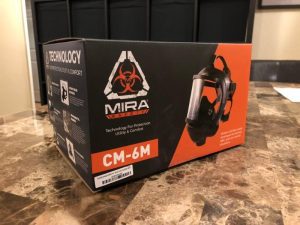
The MIRA Safety CM-6M military-grade gas mask offers excellent value, combining modern comfort features and proven reliability at a competitive price, making it an ideal choice for most new buyers. It includes a panoramic, anti-fog visor for clear visibility, an integrated speech diaphragm for easy communication, and a hydration system compatible with Camelbak connectors.
However, the wide lens may limit its use with rifles or night vision goggles, though it remains suitable for use with a pistol and provides a broad field of view.
Pros
- Features a speech diaphragm
- Has a hypoallergenic inner mask
- Has an impact-resistant visor
- Helmet compatible
Cons
- Doesn’t come with the adapter for Camelbak
- Filter caps are easy to lose
3. PD-101 Full Face Respirator Gas Mask with Organic Vapor and Particulate Filtration
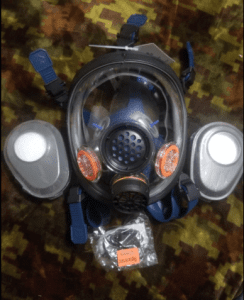
This PD-101 Full Face Respirator Mask is designed to protect against chemicals, pesticides, and other substances. It’s designed to be durable, and it can even protect you from flying debris. Yes, it’s impact-resistant.
In fact, it’s comfortable to use all day. Weighing just around 2 pounds (even with the filters attached), you won’t have problems wearing it on the job. It also has a 200° field of view, which is actually good. With a dual-convex design, it offers excellent visibility and spatial awareness.
Pros
- Fits larger and wider faces
- Comes with an anti-fog treatment
- Has a large voice diaphragm that allows for better and more effective communication
Cons
- Filters aren’t NIOSH-compliant
4. PD-100 Full Face Respirator Gas Mask with Organic Vapor and Particulate Filtration
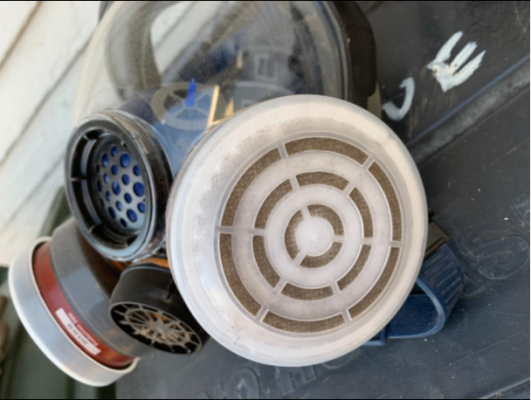
Designed to provide protection from inhaling 95% of particles in the air, this mask is quite similar to the previous one. This means that it’s easy to use and durable. It has a really excellent seal that you can wear even if you have facial hair.
Now, how are they different? The only difference between the two is their type of filter connector. Unlike PD-101, which is compatible with other companies’ filters, this mask only uses a proprietary filter connector.
The mask also feels comfortable and sturdy. It features a gasket made of multi-layered silicone, which conforms nicely to the shape of your head.
The straps and buckles aren’t flimsy as well; they’re actually durable and dynamic. You can adjust each strap for a better fit. And in case you wear glasses all the time, this may not be the best choice for you. Your frame will likely create a leak around its seal, and that’s not something you’d want when you’re in danger.
Pros
- It can be adjusted to get the perfect fit
- It can be used with other filter brands
- Comes with a protective face shield that allows a wide range of vision
Cons
- Filters aren’t NIOSH-approved
5. 3M Respirators – Full Facepiece Fr-M40B Respirator CBRN Assembly
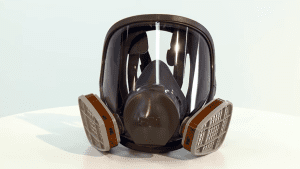
This particular mask features designs suitable for first responders. With its silicone material, you will not have a hard time getting an excellent fit without sacrificing comfort. It also has an optional butyl rubber second skin, which works well in lowering decontamination costs while increasing respirator life.
The mask is easy to wear. And once it’s on, it provides excellent protection against different chemical agents.
Pros
- NIOSH approved
- Comes with two speaking diaphragm
- Offers excellent permeation protection
Cons
- A bit expensive when compared with other models that offer the same features
6. Sperian Opti-fit CBRN Gas Mask Lg 779000 Hat Size
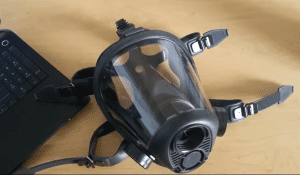
The Sperian Opti-fit Cbrn Gas Mask is on the expensive side, but its features make it worth every cent you spend on it. It’s durable and chemical resistant, which are two things you’d need in an effective mask.
It offers an excellent field of vision with its anti-scratch-coated polycarbonate lens. You will not experience obstruction or distortion, which is important when you’re in critical situations. It also has a standard nose-cup, which helps reduce lens fogging.
It comes with a 3-position canister mounting, which can accommodate different applications. Plus, it has a hydration drink tube which you can use for quick hydration.
This particular mask is equipped with DIN-threaded 40 mm connectors. These work really well in making attaching and removing canisters fast and easy.
Pros
- Comes with an optional hydration drink tube
- Offers superior field of vision
- Polycarbonate lenses are anti-scratch-coated
Cons
- A bit expensive compared to other models
7. NORTH Honeywell 7600 Full Facepiece Silicone Respirator
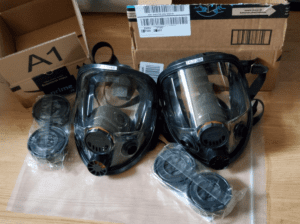
NORTH Honeywell 7600 Full-Facepiece Silicone Respirator is suitable to use in any work environment. It has front and side mounts that can be used as a Continuous Flow Supplied Air Respirator and a Powered Air Purifying Respirator.
When it comes to vision, you will not have any problems with this mask, particularly with distortion or clarity. It has an extra wide viewing field and excellent peripheral and downward sightlines.
Its lenses are made of tough polycarbonate lenses. It’s also been tested to meet the ANSI Z87 High Impact Standards for your safety in your workplace.
When it comes to seals, it does an excellent job of keeping contaminants away. It features a 5-point head strap option, which makes putting on and adjusting easier. Conversation is easy with this mask, too. It’s designed with the Kapton Speech Diaphragm that enhances conversations.
Pros
- Minimizes distortion
- Offers superior comfort and fit
- NIOSH-approved
Cons
- A bit heavy after a while of use
8. Honeywell Silicone Full Facepiece Respirator w/ 5-point Head Strap
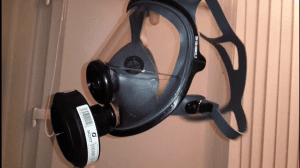
Among the other masks in the Honeywell Respirator Product line, this one has the most options for configurations. It’s great for protecting against airborne particles, contamination, chemicals, gas, vapors, and smoke.
The mask is designed with a silicone seal that does an excellent job of creating a barrier against threats. It features a silicone nose cup to ensure comfort even if you wear it all day. As for the field of vision, this one didn’t disappoint me. A polycarbonate lens gives a wide field of vision, and its peripheral and downward views are excellent as well.
Pros
- Great fit
- Excellent field of vision
- Silicone nose cup ensures comfortable all-day wear
- Super wide view
Cons
- Doesn’t come with a case
- A bit difficult to find replacement parts
- Doesn’t have a voice diaphragm
9. ST-100X Survival & Tactical Full Face Respirator
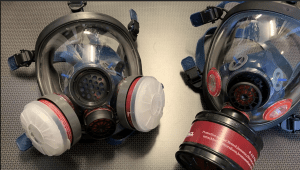
ST-100X Full Face Respirator Gas Mask made it to this list because it is compact, lightweight, and durable. Apart from offering protection against toxic environments, it can also withstand brute force.
The mask comes with a standard 40mm threaded adapter as well as one P-D-1 carbon-activated charcoal filter. These are great for organic filtration.
Communication is easy with this mask, too. It has a speaking diaphragm that allows me to communicate even without removing the respirator.
The mask also has a no-fog feature. This ensures that it never collects moisture, and it prevents the buildup of excessive heat as well.
Pros
- Features a heavy-duty filtration system
- Comes with a full warranty
- No fogging of the lens
Cons
- Rubber straps and plastic mounts seem to be a bit weak
Why Do You Need A Military-Grade Gas Mask?
While the image of a gas mask often evokes thoughts of war and apocalyptic scenarios, these protective devices hold importance far beyond the battlefield. Military-grade gas masks offer superior defense against a wide spectrum of hazardous airborne threats, making them an invaluable asset for civilians facing chemical spills, industrial accidents, or even large-scale disasters with lingering contaminants.
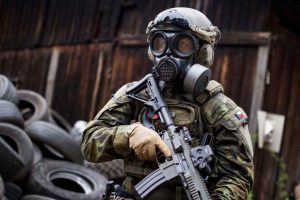
Unlike standard respirators, military-grade gas masks are built to withstand extreme conditions. They feature robust construction and specialized filters providing comprehensive protection from chemical warfare agents (CWAs), biological toxins, radioactive fallout, and a range of toxic industrial chemicals (TICs). Their design prioritizes durability, ensuring functionality even in contaminated or challenging environments.
Military-grade gas masks are engineered for extended use. This means comfortable features, easy breathing, and potential compatibility with hydration systems. Their advanced filtration mechanisms protect you for longer periods and reduce the risk associated with needing to swap filters frequently in a contaminated area.
Though designed for the most dangerous circumstances, a military-grade gas mask can be an invaluable preparedness tool for civilians. In the event of unexpected accidents, natural disasters with harmful residues, or even acts of terrorism, having this level of protection can be the difference between mere survival and safe, comfortable endurance.
How Gas Masks Work
Gas masks work on a similar principle to water filters. It acts as a filter catching anything carried in the air so that what you are consuming is clean oxygen. How does it do this? It works in two ways:
Simple filtration
The mask uses a simple particle filter, similar to a water filter, to remove bacteria from the air you breathe. It acts as a physical barrier, akin to holding a cloth over your mouth to block smoke, but it can filter much finer particles.
Adsorption
Adsorption is a chemical process used in gas masks to remove toxic gases and molecules. This is what differentiates gas masks from respirators or using a wet cloth over the mouth during a fire escape. While respirators and damp cloths can trap particles, they do not filter out toxic gases.
These two processes occur in an attachable filter on a gas mask, which uses activated or oxidized charcoal. This charcoal acts like a ‘sticky fence,’ trapping toxins carried by the airflow. Since filters need to be replaced regularly, it’s wise to have spare cartridges on hand to ensure continuous protection.
Here’s a video that explains how gas masks and respirators work, including a detailed discussion on the operation of contemporary gas mask filters that remove dangerous substances.
Selecting the Right Gas Mask for Your Needs
Having the best gas mask in the world won’t help you if it doesn’t fit or doesn’t protect against the right threats. Choosing wisely starts with understanding these key factors:
1. Purpose
The use of a gas mask depends on the individual’s needs. For instance, you might need one for working with toxic paints and aerosols, or you could be a first responder who needs to avoid hazardous airborne chemicals. The purpose of your gas mask determines what type you should choose.
If you plan to use your gas mask to breathe clean air during a nuclear attack or to keep your air supply uncontaminated in areas with known epidemics, then you should consider a CBRN or NBC mask. Both types are designed to protect against nuclear and biological threats.
2. Type
When choosing the right gas mask, it’s crucial to assess the specific hazards you might face. Various types of CBRN/NBC gas masks are designed for different scenarios. For instance, industrial paint gas masks are perfect for those working with volatile paints and solvents, offering protection against harmful chemical vapors. Chemical gas masks are essential for individuals exposed to toxic chemicals, particularly in environments like chemical manufacturing or spill responses.
Additionally, if you are concerned with airborne diseases, especially in pandemic conditions, certain masks are specifically designed to protect against biological threats.
3. Duration of use
Gas masks and their components, such as filters and cartridges, typically have expiration dates. The masks themselves are made of materials that can degrade over time, which can affect their fit and seal. This is crucial because a proper seal is essential for the mask to function correctly and protect the wearer from hazardous substances.
Filters and cartridges, which provide the actual protection by trapping or chemically neutralizing harmful agents, also have shelf lives. These components can degrade due to factors like humidity and temperature, and they might become less effective after their expiration date.
Manufacturers usually provide these expiration dates on the packaging or the products themselves. Here’s how you can typically find and interpret these dates:
Check the packaging: Often, the expiration date or “use by” date is printed on the mask or filter’s packaging. This is usually found in a clear, standardized format.
Look on the mask or filter: Sometimes, the expiration date is stamped or printed directly on the mask or the filter. This might be in the form of a date (e.g., “EXP 2025/12”) or sometimes as a batch code which might include the date of manufacture.
Date of Manufacture: Instead of an expiration date, some manufacturers provide a date of manufacture. You might need to refer to the product’s manual or manufacturer’s website to determine how long the product is effective after the manufacture date.
Manufacturer’s Instructions: Always refer to the manufacturer’s instructions or their website for specific guidance on where to find and how to interpret expiration dates. Different manufacturers might use different systems.
Contact the Manufacturer: If the expiration date isn’t clearly marked or you’re unsure how to read it, you can contact the manufacturer’s customer service for clarity.
4. Seal
The most important part of a protective gas mask is the seal that it makes on the face. If the mask cannot make a seal, then it cannot create a clean air environment for you to breathe clean, uncontaminated oxygen. It is also the responsibility of the wearer to ensure that they have removed any facial hair that can stop the mask from creating a seal around the face.
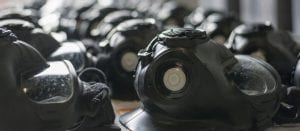
5. Filters
Most gas masks are equipped with a standard filter, typically the NATO 40mm filter, which is widely available and fits most models. However, despite the common use of the NATO 40mm filter, it’s essential to verify the specific type of filter required by the gas mask before making a purchase.
6. Budget
With various CBRN and NBC gas masks available, finding one that fits your budget should be straightforward. High-quality military gas masks typically range from USD $200 to $350, offering greater effectiveness and comfort, improved visibility, and enhanced features.
For those on a tighter budget, the Israeli Defense Force NBC gas mask is an excellent option for less than USD $50. This makes it a cost-effective choice without compromising on essential protection.
The Importance of Filters
Think of your gas mask as a shield; the filters are the specialized armor that deflect specific threats. Understanding filter types and their capabilities is essential for making the right choices for your protection.

Particulate Filters: These trap physical particles like dust, smoke, and biological agents (viruses, bacteria). They’re rated with codes like P100 or N95; the higher the number, the better the filtration.
Gas and Vapor Filters: These adsorb harmful gases using activated charcoal or other materials. They’re coded by letters and colors indicating the types of gases they protect against.
For example:
- A (Brown): Organic Vapors
- B (Grey): Inorganic Gases
- E (Yellow): Acid Gases
- K (Green): Ammonia
Combination Filters: These tackle both particulates and specific gas threats, offering broader protection.
It’s important to note that filters don’t last forever. If unopened and stored properly, filters can have a decent shelf life (sometimes exceeding 10 years). Once exposed to air, filter materials start degrading.
Be sure always to track when you open a filter and follow the manufacturer’s expiry guidelines. Increased breathing resistance, unusual smells or tastes coming through, or if the filter has been physically damaged.
Here’s a comparison table of different types of filters commonly used in CBRN gas masks:
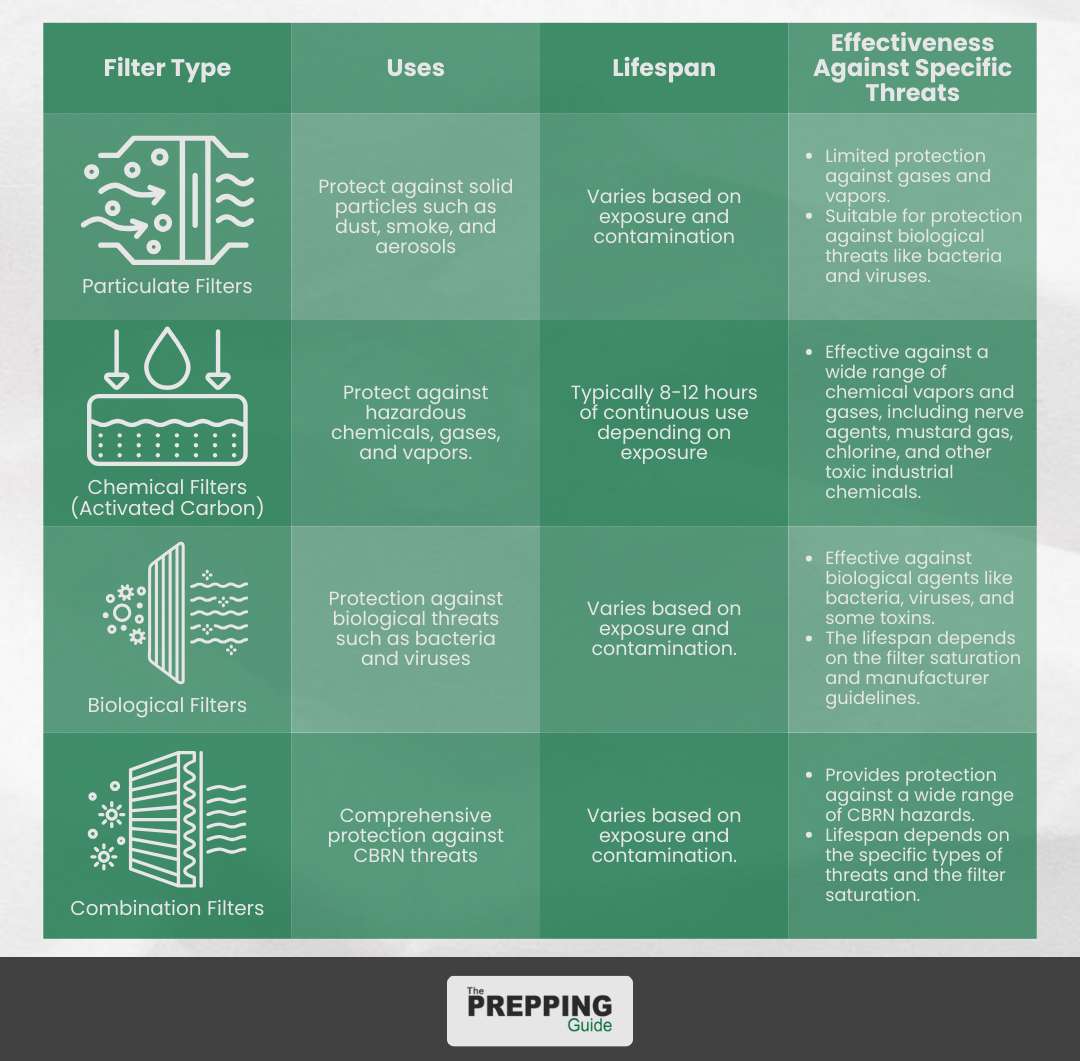
CBRN Preparedness and Practical Tips
Hoping for the best is never a good strategy when dealing with potential CBRN disasters. Proactive preparation is your most powerful tool for ensuring you and your loved ones survive.
Gas Mask & Filters: Choose appropriate gear based on your needs and potential threats. Have spare filters readily available, and remember those expiry dates!
Protective Clothing: Depending on the scenario, you might need suits, gloves, and boots to prevent skin exposure to contaminants.
Water & Food: Store non-perishable food and clean water, ideally in sealed containers.
First Aid: A well-stocked kit for basic injuries and decontamination procedures.
Communication: A way to receive emergency alerts and updates (battery-powered radio, etc.)
Plan & Knowledge: Have a designated safe location with your supplies. Know the evacuation procedures for your area.
Practice Donning & Doffing: Putting on and removing your mask quickly and correctly should become second nature.
Movement Drills: Practice basic tasks like walking, climbing, and communicating while wearing your mask.
Storage: Store your protective gear in a cool, dry, and easily accessible location.
Regular Inspections: Check for any damaged components, expired filters, or signs of deterioration.
It’s important to consider CBRN preparedness as a continuous process. As threats evolve and your circumstances change, revisit your checklist and training. Preparedness brings peace of mind and drastically increases your chances of survival.
Conclusion: Your Safety, Your Responsibility
The world can be unpredictable, and CBRN threats, however remote they may seem, are a harsh reality we must prepare for. By understanding gas mask technology, selecting the right gear, training diligently, and maintaining a broader preparedness mindset, you take control and drastically increase your odds of survival.
Frequently Asked Questions
What is the best gas mask for a nuclear fallout?
Both an NBC gas mask and a CBRN gas mask will keep your air supply decontaminated from radiation that would be in the air after a nuclear attack. All of the gas masks above, fitted with an NBC gas mask filter, will filter radiation from any air that passes through the filter of the gas mask.
What is the best gas mask for a chemical attack?
In the case of a chemical attack, the gas mask you need to ensure you don’t breathe in any of the gas or vapor-based toxic agents is an NBC or CBRN gas mask, as both cover the basic necessity of filtering chemicals from coming in contact with the body.
Can I use an NBC gas mask if there is limited oxygen?
According to NIOSH standards, CBRN gas masks are not for use in environments where there are less than 19.5 percent oxygen levels. Gas masks are air-purifying systems and do not supply oxygen. Instead, if an environment is void of oxygen, a self-contained breathing apparatus (SCBA) must be selected for use in those environments.
Will a CBRN gas mask protect me from a dirty bomb or nuclear attack?
Short answer, yes. However, a CBRN gas mask only provides respiratory protection against inhalation of radiological, nuclear, biological, and chemical dust particles. The respirator does not stop all forms of radiation that may be emitted by these particles or radiation released from a nuclear attack.

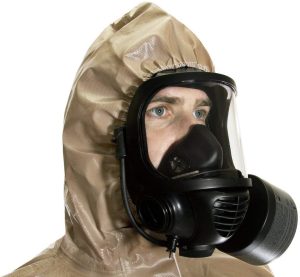
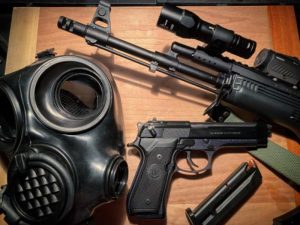
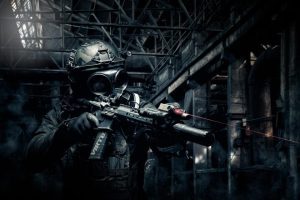
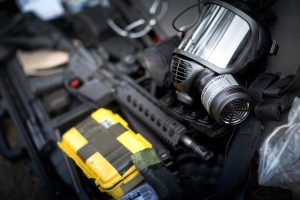
Ben, thank you for writing this. There is not as much information online about CBRN masks as I would have liked and yours was definitely a great guide with good comparisons.
I ended up purchasing the SGE CBRN mask. I chose it as it seems like they are all top quality masks, however the SGE has a much wider face shield and is a newer model. I’ve used it a few times in short runs and exercises and am very happy with it!
i agree thank you for helping find a well working gas mask that is resonably priced but will still work for how i want it..
Thank you for this article and your knowledge!
Hi, I am new to all this and came here due to the current Corona Virus events. I see above you mention that the Draeger 6300 is a cheap NBC option. Where do you know if a mask is NBC protective or not? I have been to the Draeger website, but I find nothing in regards to biological dangers. I understand the other half of this is the filter, but I cannot do a match of the ask and filters to qualify this ask as NBC. Again sorry for my ignorance. Thanks in advance to anyone responding.
Me too. I think the term to remember here is It is better to have and not need then to need and not have. So over buying should not be a problem. That means the higher end. After all , if you go cheap and get Corona (the virus not the beer), then the saved money has cost you your health and maybe your life.
I personally will purchase the M50 from Avon in the future. It is the only one I’ve tried before but it fits me well… Plus Im in the US Military so all my training is done in the M50 and I’d have to report to the closest military base in the event of an attack, so I know I’d have a humongous supply of filters, my only worry would be having enough on hand to report to a US military installation…. Works well for shouldering my barrett MRAD as well.